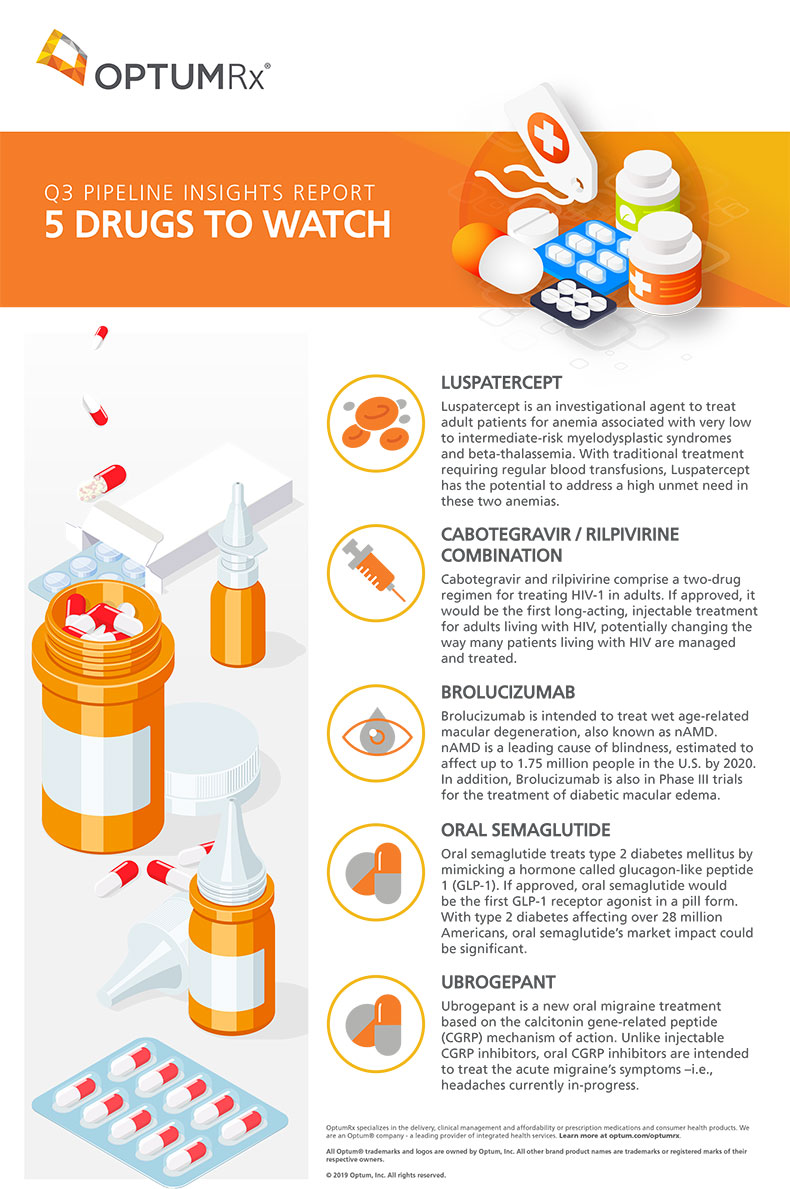Rybelsus, Other Treatment Improvements For Chronic Disease Have OptumRx’s Attention
Executive Summary
UnitedHealthcare’s pharmacy benefit manager highlights potential cost pressures from upcoming novel or improved treatments for diabetes, wet AMD, HIV and migraine, as well as luspatercept for beta thalassemia, in its latest pipeline report.
[UnitedHealthCare]’s pharmacy benefit manager OptumRx Inc. flags Novo Nordisk AS’s just-approved oral semaglutide for type 2 diabetes, Rybelsus, and a handful of other novel or improved treatments for chronic conditions as near-term launches with potentially significant economic impacts in its latest Pipeline Insights Report.
The Q3 report, which is the second to be issued by the major PBM, offers a snapshot of potentially high-cost drugs payers are expecting to reach the market in the coming months. Its focus on chronic-use treatments contrasts with the first OptumRx pipeline report, which highlighted drugs for rare diseases. (Also see "OptumRx WatchList Includes Rare Disease Drugs, Potential Price Disruptors" - Scrip, 30 May, 2019.)
The drugs included in the new report are expected to generate high levels of spending because they target large audiences; the earlier report focused on drugs for smaller patient groups that demand very high prices.
In addition to Rybelsus, the Q3 report covers upcoming drugs for wet age-related macular degeneration, HIV and migraine. It also covers a new treatment for anemia in patients with myelodysplastic syndromes and beta-thalassemia (see graphic below).
“Many of these medications take a different or novel approach to treatment and are likely to benefit larger groups of patients,” OptumRx said of its latest report. “It is likely that patients and providers will want to try these new treatments, particularly members with chronic, long-standing diseases who have found little success previously.”
The PBM expects that introductory market prices for the new drugs “will be similar to existing medications” but may find greater uptake because they are easier to take. That could significantly boost the cost of treatment.
For example, OptumRx notes that GLP-1 agonists (like Rybelsus) “are priced significantly greater than other branded diabetes drugs and if oral semaglutide enters at a similar price point, then overall costs of treating diabetes could increase.”
Novo Nordisk has not announced pricing for the new drug. However, “one analyst firm projects oral semaglutide will see sales at over $2bn by 2024,” the report points out.
“With type 2 diabetes affecting over 28m Americans, oral semaglutide’s market impact could be significant,” OptumRx said. “The currently available GLP-1 agonists work well, but if an oral form becomes available, any barriers caused by the route of administration (subcutaneous injection) will be eliminated. We see great potential for increased utilization.”
Brolucizimab’s First Approval In October?
Novartis AG’s new treatment for wet age-related macular degeneration, brolucizumab, may offer better efficacy and less-frequent dosing than the other FDA-approved treatments for the condition, Regeneron Pharmaceuticals Inc.’s Eylea (aflibercept) and Genentech Inc.’s Lucentis (ranibizumab), OptumRx observed.
“Analysts predict that brolucizumab will reach annual sales over $1bn globally by 2021, and that it will become the most profitable AMD drug by 2026,” according to the report.
However, brolucizumab may face biosimilar competition during that time. The US patents for Eylea and Lucentis both expire in 2020 and when/if biosimilars currently in development come to market, “there could be additional price competition in the class,” the report points out.
FDA approval for brolucizumab in wet AMD could come “in or around” October, with a launch anticipated by the end of the year. SC125067 The company is also expected to file for approval for the drug in diabetic macular edema in 2020.
ViiV Healthcare and Janssen Pharmaceutical Cos.’s long-acting injectable combination of cabotegravir and rilpivirine can reduce dosing frequency for HIV patients from 365 times per year to potentially less than 12 times a year, the report notes, adding that up to 25% of HIV patients stop taking their antiretroviral therapy for some period of time.
The long-acting version could lead to “both improved patient satisfaction and medication adherence,” the report says. The deadline for FDA action on the once-per-month version of the combination is 29 December.
Allergan PLC’s oral migraine treatment, ubrogepant, is also expected to reach the market in late 2019. A calcitonin gene-related peptide (CGRP) drug, it is intended to treat acute migraine symptoms. (Also see "Allergan's Ubrogepant Succeeds In Second Acute Migraine Phase III Study" - Scrip, 27 Apr, 2018.)
Pricing for the new drug “is a concern,” OptumRx said. It will compete with triptans, which are generic and cost as low at $20 or $30 per month. Currently marketed injectable CGRPs have list pricing of around $575 per month, which could serve as a guide to pricing for the oral form.
However, “these [injectable] treatments may not be the best reference, since they are administered on a chronic basis for headache prevention, whereas ubrogepant will be used as needed for the acute treatment of migraine headaches,” the report acknowledges.
First Treatment For Beta-Thalassemia
Luspatercept is the outlier in the report in the sense that it is intended for less-common conditions. Being developed by Acceleron Pharma Inc. and Celgene Corp., luspatercept could be the first-ever drug approved to treat beta thalassemia and “will come at a high price,” the report assumes. (Also see "'Totality Of Data' Make A Case For Luspatercept In Beta-Thalassemia, MDS" - Scrip, 3 Dec, 2018.)
An erythroid maturation agent, it is also being developed for intermediate-risk myelodysplastic syndromes (MDS) and offers the potential treat a high unmet need in those two anemias.
Industry analysts are projecting luspatercept will generate sales of more than $2bn in the two conditions. FDA has set target action dates of 4 December for the beta-thalassemia indication and 4 April 2020 for the MDS indication.
However, the drug could quickly face price increased competition from bluebird bio Inc.’s Zynteglo, a one-time gene therapy that also treats beta thalassemia. Zynteglo may be approved in mid-to-late 2020 in the US, OptumRx suggested. (Also see "Bluebird Lays Some New Eggs, But They'll Take Time To Hatch" - Scrip, 16 May, 2019.)

